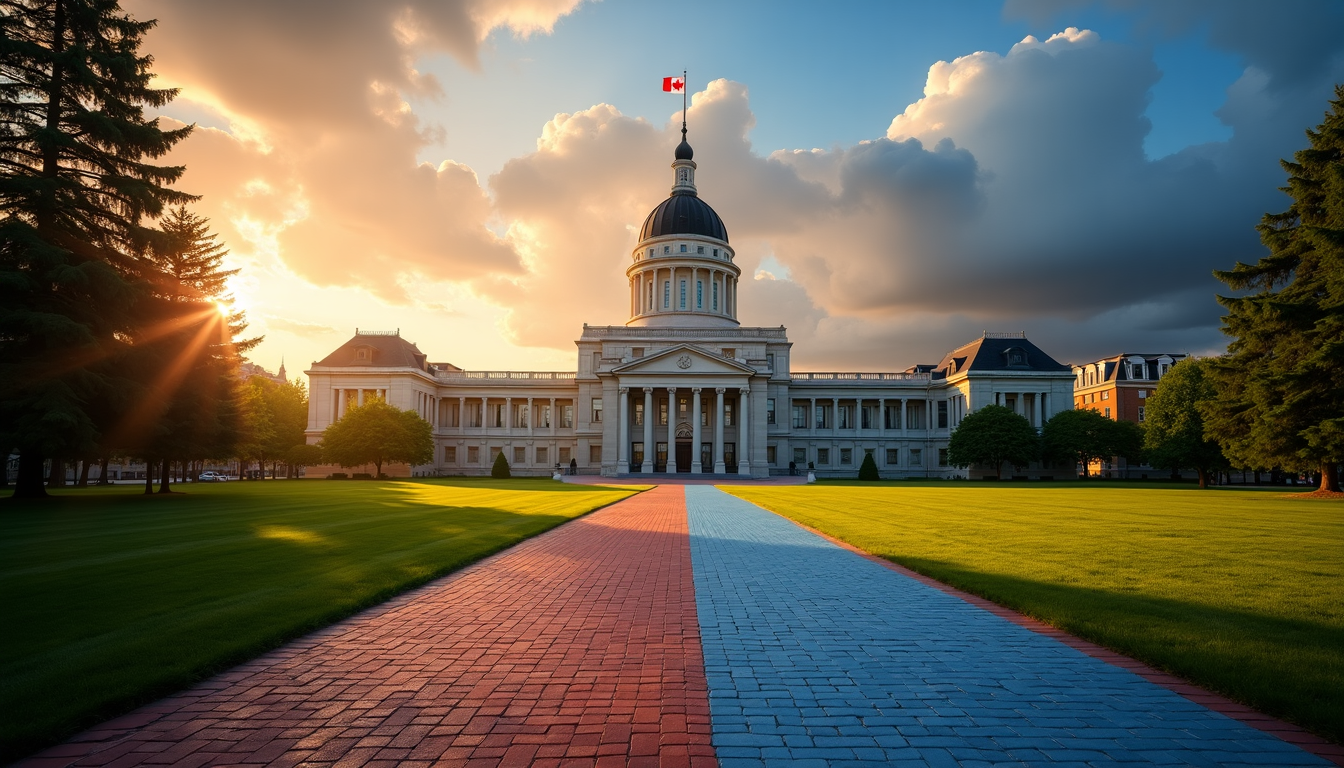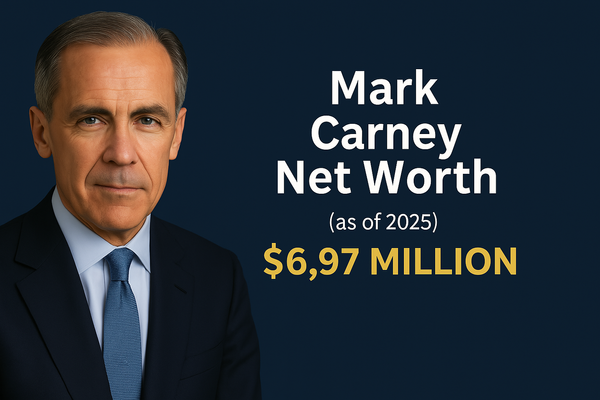10 Campaign Promises That Define Pierre Poilievre's Vision

Most Canadians - seven out of ten - share Pierre Poilievre's view that Canada is broken. A surprising 43% of Liberal voters agree with this assessment. Poilievre's campaign promises have struck a chord with voters since he became the Conservative Party leader in 2022. National surveys show his consistent lead that points to potential majority government support.
Poilievre's vision for Canada calls for major changes in many sectors. He promises the "biggest crackdown on crime in Canadian history" and plans to eliminate the carbon tax. His agenda focuses on aggressive housing development targets for major cities and optimized immigration processes. A proposed "Pay-As-You-Go Law" would control federal spending, showing his steadfast dedication to fiscal restraint and what he describes as a return to "common sense politics."
This detailed analysis looks at Poilievre's key campaign promises that shape his political vision. It reveals how these promises might affect Canada's future and what they mean for different groups of people.
Breaking Down Poilievre's Economic Vision
Pierre Poilievre's economic blueprint shows his vision of a smaller government with greater market freedom. His plan revolves around three connected pillars: tax reform, housing affordability, and less bureaucracy.
Tax Reform and Fiscal Policy
The life-blood of Poilievre's tax reform agenda lies in his promise to reverse the capital gains tax hike. A report from the C.D. Howe Institute shows this tax increase would lead to over 400,000 job losses and reduce Canada's GDP by nearly CAD 125.40 billion [1]. The plan also removes federal sales tax on new homes under CAD 1.39 million, which could help homebuyers save up to CAD 55,734.41 on their total mortgage payments [2].
Housing Affordability Initiatives
Poilievre's housing strategy brings bold measures to tackle Canada's housing crisis. His "Building Homes Not Bureaucracy Act" has three key mechanisms:
- Cities need to build 15% more homes yearly or risk losing federal funding based on missed targets [3]
- Cities won't get transit and infrastructure funding until they build enough high-density housing near transit stations [4]
- Cities that block new housing developments will face NIMBY penalties [4]
The plan wants to convert 15% of the federal government's 37,000 buildings into affordable housing within 18 months [3]. These initiatives target areas where housing costs have skyrocketed - especially in Toronto, ranked as the world's worst housing bubble [3].
Small Government Philosophy
Poilievre promotes "small government that minds its own business" [5]. He wants to cut bureaucracy, reduce consultants, and limit foreign aid [6]. These savings would go toward reducing deficit and cutting taxes to "let loose the free-enterprise system" [6].
Poilievre believes government interference has created current economic problems. He points out that Canada built fewer homes in 2022 (219,000) than in 1972 (232,000), even though the population doubled [7]. His economic vision puts faith in personal responsibility and market solutions rather than government control. This reflects his long-held belief that "a dollar left in the hands of consumers and investors is more productive than a dollar spent by a politician" [5].
Energy and Environmental Commitments
Pierre Poilievre's environmental strategy represents a major shift from current federal policies. He wants to focus on technological solutions and economic development while proposing big changes to existing environmental frameworks.
Carbon Tax Elimination Strategy
Poilievre's environmental agenda prioritizes the elimination of the federal carbon tax. The system currently adds approximately 18 cents to a liter of gasoline [8]. His strategy lines up with President Biden's climate bill in the U.S., which created over 300,000 new green jobs in just two years [8].
Natural Resource Development Plans
The resource development strategy features an innovative First Nations Resource Charge program. First Nations could collect 50% of federal taxes from industrial activities on their lands through this optional system [9]. This policy would simplify project approvals and provide tax credits to participating industries [10].
Poilievre's natural resource development plan highlights:
- Hydroelectric potential in Quebec and Manitoba
- Uranium resources in Saskatchewan
- Offshore tidal power development
- Carbon capture and storage initiatives [11]
Green Technology Approach
Poilievre promotes a "tech not taxes" approach to tackle climate change instead of carbon taxation [12]. His plan would speed up the approval process for clean energy projects [11]. The Canadian Climate Institute reports that industrial carbon pricing drives the largest share of emissions reductions, which could reach half of the projected reductions by 2030 [8].
The strategy would simplify permits for clean energy initiatives of all types. Critics say this approach might not meet international commitments. However, supporters point to Alberta's TIER fund, which has gathered CAD 1.39 billion for carbon capture projects and renewable energy transitions [8]. Ontario's Emissions Performance Standards program expects to collect over CAD 2.79 billion by 2030 for clean energy investments [8].
Climate inaction could lower GDP by CAD 48.77 billion by 2030 [13]. Poilievre's strategy tries to balance environmental protection with economic growth through technological advancement and simplified regulatory processes.
Social Program Reforms
Social program reforms are the foundation of Pierre Poilievre's campaign platform. His vision aims to reshape Canada's welfare system.
Senior Benefits and Pension Plans
The Conservative leader takes a careful approach to senior benefits. His party backed a motion to raise Old Age Security (OAS) by 10% for seniors aged 65-74. This would cost CAD 22.29 billion over five years [14]. Poilievre stressed tax cuts as a better way to boost seniors' purchasing power when asked about putting this plan into action [14].
The need for pension reform is clear. Benefits for the elderly, which include OAS and the Guaranteed Income Supplement, make up the biggest share of federal spending. The Parliamentary Budget Officer expects OAS costs to rise from CAD 112.30 billion this year to CAD 326.05 billion by 2055-56 [15].
Healthcare System Changes
Poilievre wants big changes to Canada's healthcare system. He puts patient choice at the center of his plans. His proposed changes include:
- Removing federal limits on private healthcare options
- Letting provinces set up hybrid healthcare models
- Supporting provincial control over healthcare delivery
- Cutting wait times through competitive service delivery [16]
A recent Leger poll shows 64% of Canadians think the healthcare system needs "major change." Only 5% believe more funding would fix the problems [16]. Poilievre pointed out that 30 years of increased funding hasn't solved these systemic problems [16].
Support for Young Families
The Conservative leader's family support plan focuses on giving families more financial freedom. He previously promoted improvements to the Universal Child Care Benefit. This provided up to CAD 2,675.25 yearly for children under six and CAD 1,003.22 for those aged 6-17 [17]. These measures helped parents invest in their children's future.
Poilievre links family planning with housing costs. He says Canada's housing crisis stops young families from growing. He notes that many young women hear their "biological clock ticking" while they wait to buy homes [18]. His strategy helps young Canadians reach traditional life goals through better economic opportunities [18].
Government Institution Overhaul
Pierre Poilievre's proposed government overhaul rests on sweeping institutional reforms. His vision focuses on three major areas of federal operations that will reshape how government institutions serve Canadians.
CBC Funding Changes
The Conservative leader's stance on the Canadian Broadcasting Corporation shows his media reform vision. He wants to cut approximately CAD 1.39 billion in yearly taxpayer funding to CBC's English services [19]. We focused on protecting French-language programming because Radio-Canada plays a vital role for francophone minorities. Recent data reveals that 78% of Canadians want to keep the CBC [20]. Yet Poilievre believes private markets can now deliver most CBC services thanks to technological progress.
CBC's financial management has raised questions lately. The broadcaster approved CAD 25.64 million in bonuses for nearly 1,200 employees and cut 141 positions [21]. Poilievre responded with plans to sell CBC's headquarters to develop housing [21].
Bank of Canada Reforms
Poilievre wants major changes to Canada's central bank operations. His reform package would give the auditor general more power to review Bank of Canada activities [22]. This oversight would get into the bank's pandemic-era policies that Poilievre claims drove up inflation through quantitative easing.
His banking reform would stop the Bank of Canada from developing digital currency [22]. The central bank continues to work on its digital currency project [22]. Poilievre worries about privacy, saying a government-backed digital currency could let officials track citizens' spending habits [22].
Bureaucracy Reduction Plans
The bureaucratic overhaul would make government operations more efficient through these measures:
- Reducing executive levels from five to three tiers [1]
- Reorganizing over 300 departments and agencies [1]
- Restructuring Public Services and Procurement Canada into separate procurement and real estate entities [1]
These changes match what former top bureaucrats promote as needed structural reforms [1]. The Treasury Board would get more power through new laws, and its minister would serve as the government's Chief Operating Officer [1]. This plan tackles the core team bloat and operational inefficiencies in federal institutions.
Immigration and Housing Integration
Pierre Poilievre's campaign platform places immigration policy at its life-blood. His approach connects newcomer admissions directly with Canada's housing capacity and economic needs.
Newcomer Policy Changes
Canada's rapid population growth has prompted Poilievre to propose major reforms to immigration policies. The Conservative leader highlights some eye-opening numbers. Non-permanent resident figures jumped from 1.3 million in 2021 to nearly 2.8 million by 2024's second quarter [23]. International student numbers tell a similar story. They climbed from 350,000 in 2015 to over 1 million last year [24].
The proposed reforms include:
- Stricter verification of international student admissions, requiring proof of housing and financial means
- Scaling back temporary foreign worker programs to pre-pandemic levels
- Meeting private-sector employer needs and family reunification
- Giving priority to refugees who can quickly join the workforce [4]
Housing-Immigration Connection
Poilievre's population management strategy rests on the link between immigration and housing availability. Canada's population grows at 3% yearly through immigration, yet housing stock increases by only 1.4% [24]. The numbers paint an even starker picture when we look back. Canada built fewer homes in 2022 (219,942) than in 1972 (232,227), even though the population has almost doubled [2].
Poilievre promises to keep population growth below new housing construction rates [23]. This matters because newcomers face an 11.6% unemployment rate, which is a big deal as it means that the national average of 6.4% [23].
Skills Recognition Reform
The Conservative leader wants to fix Canada's inefficient skills recognition system. He supports a "one-stop shop" model to replace the current maze of 13 different regulators and standards [3]. His plan promises to review professional credentials within 60 days of application [25].
Healthcare professionals stand to benefit greatly from these changes. Thousands of internationally trained medical graduates remain unlicensed while we face critical shortages [25]. Poilievre and provincial partners want a nationwide agreement. This would let immigrants start their licensing process before they arrive in Canada [25].
The Conservative platform strengthens regional programs like the Provincial Nominee Program and Rural and Northern Immigration Pilot [4]. These programs match immigrants with local labor needs and help address regional workforce gaps. The proposed system would review applications based on testing ability instead of country of origin [25].
Conclusion
Pierre Poilievre's vision for Canada marks a major shift from current policies. He wants to make fundamental changes to the economy, society, and how institutions work. His market-driven solutions tackle the biggest problems like housing costs, immigration control, and making government work better.
The success of these bold plans hinges on smooth coordination between federal, provincial, and municipal governments. The Conservative leader has set clear targets that anyone can measure: 15% more housing each year, better immigration processes, and specific reforms to institutions.
Poilievre believes that a smaller government with fewer rules can fix Canada's problems today. He blends traditional conservative ideas with practical fixes for modern challenges - from not having enough homes to recognizing professional credentials.
These sweeping reforms could reshape Canadian society in many ways. Voters need to understand these proposed changes and how they might affect housing prices, economic growth, and the future of social programs.
FAQs
Q1. What are Pierre Poilievre's main economic proposals? Poilievre's economic vision focuses on tax reform, including reversing capital gains tax hikes and eliminating federal sales tax on new homes under $1.39 million. He also proposes aggressive housing development targets and a "Pay-As-You-Go Law" to control federal spending.
Q2. How does Poilievre plan to address Canada's housing crisis? Poilievre's "Building Homes Not Bureaucracy Act" includes measures such as requiring cities to increase housing construction by 15% annually, withholding transit funding until high-density housing near transit stations is built, and implementing penalties for municipalities blocking new housing developments.
Q3. What is Poilievre's stance on environmental policies? Poilievre advocates for eliminating the federal carbon tax and focuses on a "tech not taxes" approach to addressing climate change. His plan emphasizes accelerating approval processes for clean energy projects and natural resource development, including a First Nations Resource Charge program.
Q4. How does Poilievre propose to reform Canada's healthcare system? Poilievre's healthcare reforms focus on expanding patient choice by removing federal restrictions on private healthcare options, enabling provinces to implement hybrid models, and addressing wait times through competitive service delivery. He emphasizes systemic changes over increased funding.
Q5. What changes does Poilievre propose for immigration policies? Poilievre's immigration reforms include stricter verification for international student admissions, scaling back temporary foreign worker programs, and prioritizing refugees who can quickly integrate into the workforce. He also proposes linking immigration levels to housing capacity and streamlining the recognition of foreign credentials.
References
[1] - https://ottawacitizen.com/news/former-top-bureaucrat-calls-for-major-overhaul-of-the-federal-government
[2] - https://financialpost.com/real-estate/pierre-poilievre-pledges-tie-immigration-levels-homebuilding
[3] - https://www.ipolitics.ca/news/poilievre-calls-for-provincial-streamlining-of-credentialing-recognition-for-immigrants
[4] - https://admis.ca/blog/canada-immigration-2025-trudeau-resigns-poilievre-policies-ahead
[5] - https://www.bbc.com/news/articles/c9dpde9dxp0o
[6] - https://www.cbc.ca/news/politics/poilievre-jordan-peterson-interview-1.7423197
[7] - https://www.thestar.com/business/opinion/can-canadians-trust-pierre-poilievre-with-the-economy-here-are-some-of-the-major-changes/article_2f546ea8-6eb5-11ef-889c-e35aa8ab45ab.html
[8] - https://www.cbc.ca/news/science/carbon-pricing-ax-the-tax-1.7400568
[9] - https://www.theglobeandmail.com/politics/article-poilievre-proposes-plan-for-first-nations-to-collect-taxes-from/
[10] - https://halifax.citynews.ca/2024/02/08/poilievre-proposes-plan-for-first-nations-to-collect-taxes-from-industry/
[11] - https://nationalpost.com/news/politics/poilievre-vows-speed-approval-clean-energy-projects
[12] - https://www.cbc.ca/news/politics/poilievre-first-nations-afn-1.7260593
[13] - https://thenarwhal.ca/pierre-poilievre-carbon-tax/
[14] - https://www.cbc.ca/news/politics/poilievre-old-age-pension-1.7348714
[15] - https://nationalpost.com/news/politics/why-conservatives-are-supporting-an-increase-for-old-age-pensions-and-why-its-risky
[16] - https://financialpost.com/opinion/pierre-poilievre-demand-healthcare-choice
[17] - https://www.canada.ca/en/news/archive/2015/03/minister-poilievre-highlights-government-support-families-job-training-vancouver-board-trade.html
[18] - https://thetyee.ca/News/2025/01/08/What-Pierre-Poilievre-Told-Jordan-Peterson/
[19] - https://www.cbc.ca/news/politics/poilievre-defund-cbc-change-law-1.6810434
[20] - https://www.thestar.com/opinion/contributors/pierre-poilievre-wants-to-defund-the-cbc-heres-what-canadians-think-of-that/article_aedecc54-ac36-11ef-90d5-ef8fca66c7bb.html
[21] - https://torontosun.com/news/national/i-cant-wait-to-defund-the-cbc-pierre-poilievre-doubles-down-on-plan-to-ax-cbc-after-board-approves-bonuses
[22] - https://www.cbc.ca/news/politics/poilievre-bank-of-canada-audit-1.6433860
[23] - https://www.cbc.ca/news/politics/poilievre-immigration-cut-population-growth-1.7308184
[24] - https://torontosun.com/opinion/columnists/poilievre-promises-to-cap-immigration-tie-to-housing
[25] - https://thecaribbeancamera.com/poilievre-promises-to-fix-immigration-system/


